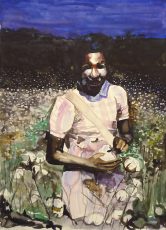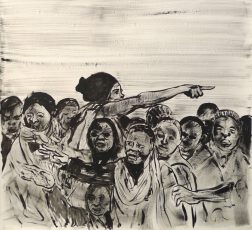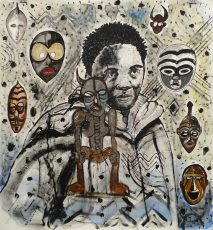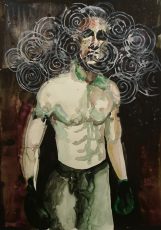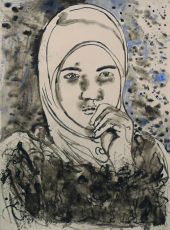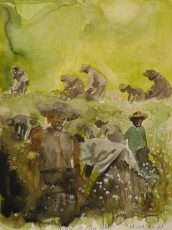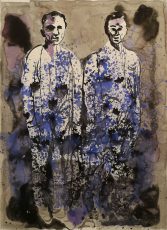The Wait
Nour-Eddine Jarram
watercolours, work on paper
28-03 through 02-05-2021
finissage Sunday 2 May 13:00 – 17:00 hours, please register at info@mauritsvandelaar.nl
Nour-Eddine Jarram (1956) came to Enschede from Casablanca in 1979 to continue his art education at the AKI. In the late 1980s he became known for his paintings interweaving works by Dutch masters with motifs from Islamic visual culture. For instance, the physicians’ heads in Rembrandt’s The Anatomy Lesson of Dr. Nicolaes Tulp were replaced by tulips. In the drawings and paintings that followed, he developed a semi-abstract world with rolling landscapes represented in warm earthy colours, in which inconspicuous figures are concealed. After moving to a new studio in a rural setting, Jarram identified with the 17th century landscape painter’s perspective, whose work he reinterpreted in large pastel drawings, sometimes adding a little calligraphic man who runs through the scene. More recently, following the growing media coverage of Europe’s increasing number of refugees, the artist has focused on depicting the experiences of the immigrant community in western society. Jarram created a series of watercolours featuring refugees as well as young urban Moroccans.
Although he is fully integrated in Dutch society and art world, he is no stranger to the difficult path of the migrant who has to forge ahead in a foreign environment. Empathically, he depicts his subjects in poignant, moving watercolours, based on news photos and selfies that young migrants post on social media. These portraits represent those pushed into the shadow of anonymity and judgment, capturing their aspirations, deeds, fears, doubts and sense of bewilderment: an exchange of gazes in which frequently misunderstood youths are given a face and a platform. The Wait stands for the refugee that lingers helplessly in hopes of reaching the coveted promised land, where he will inevitably find himself in a position of uncertain existence. The exhibition features watercolours and works on paper, depicting refugees and migrant youths, along with a series of beach scenes featuring on the one hand, carefree tourists enjoying the sun, and on the other, street vendors trying to survive.
